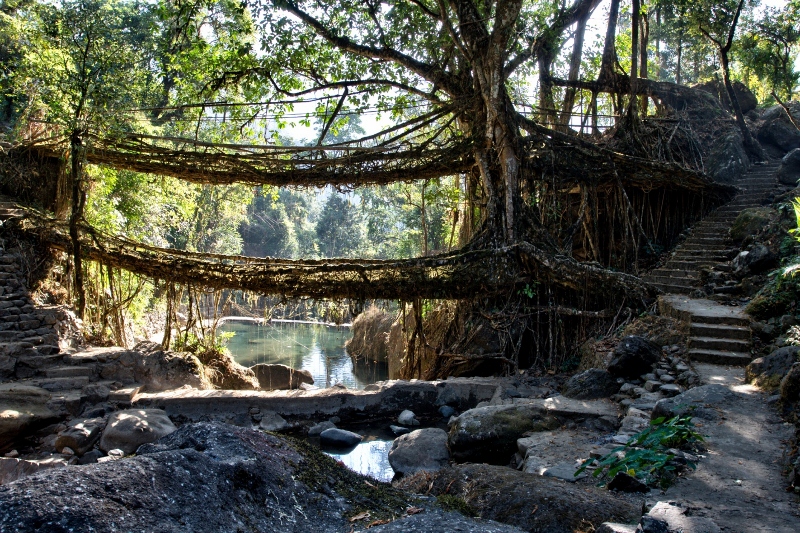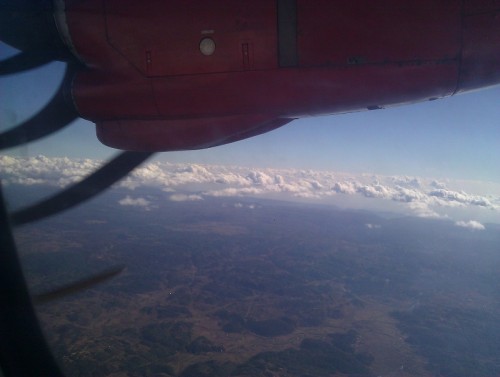Ashwin Mudigonda saw the BBC’s Human Planet, and was awestruck by the living root bridges of Nongriat (watch a video here). He decided to make a trip to Meghalaya and see the bridges. Here, illustrated by beautiful photographs, is an account of his thrilling adventure, which started with a flight to Shillong from Kolkata aboard a tiny turboprop.
Approaching Shillong, one can see why Meghalaya was named so – the abode of the clouds. One feels as if one is flying over an Amazonian rainforest, with the lush vegetation and languid fluffy clouds.
After spending the night at Shillong, I took a shared Sumo to the market in Sohra in Cherrapunjee. From here, I took a Maruthi 800 taxi to Cherra Resort. It is here that I was told that a stairway descends into the realms of the magical root-bridges.
The Cherra Market is a lively place where farmers, vendors from the area come together to sell their wares. The succulent oranges of the area are famous for their sweetness and distinctive taste. They burst in your mouth on contact and release the most delicious orange juice you have never tasted! I purchased a dozen to keep me satiated and hydrated for the journey ahead.
The farther you go away from the winding and maddening streets of Shillong, the calmer you begin to feel. After a point, it was just sheer poetry – the chilly mountain air, the rolling green meadows, the warmth of the Meghalayan sun suffusing you. Small wonder that the British christened Shillong – The Scotland of the East.
The single childhood geography trivia rushed to my head – I was in Cherrapunji, the wettest place on the planet. Yet there was not a drop of rain in sight. My slow ride to the Cherra Resort was peppered by these tidbits of information on giant boulders.
Finally, I began my descent towards the root-bridges. At first I thought this would be easy – climb down a few hundred stairs, but I was in for a surprise!
Even though I was amidst hills, the exertion took a toll and made me sweat. During the entire descent, I saw bales of drying bay leaves. It felt like I was walking into a spicy cauldron. As if to rub it in my face, locals zipped up and down, carrying heavy sacks on their backs with no effort at all. Here, a boy carries a sack of dried bay leaves downhill, towards Nongriat.
At this point, I was certain that Escher was from Nongriat! As simple as it looks, after the first fifty steps, your thighs begin to scream in pain. As I would discover on my way back, it was relatively easier going up than down. The lack of any safety rails behooves the trekker to descend in a sideways fashion lest he/she stumble onto the dirt and roll downhill.
At one of the infinite rest breaks, I spy Nongriat. The reality hits me like a sack of bricks – I was on one side of the hill, and I had to get down, cross the valley, and climb up to call it a day.
Expensive white mountain pepper grows by the acres along the stairway. This is one of the major exports of the area. The other significant items are bay leaves and loofah.
In my fatigue, I paused atop a wire suspension bridge, and there it was – the first sign of the root bridge. Centuries ago, the locals of the area must have spotted a root like this one connecting two boulders over a river, and that must have given them an idea
Compared to the big cities of India, the people here live relatively modest lives. Yet, they seem so full of life and mirth. Even asking for directions was a pleasure as this man chatted with me while puffing on his homemade pipe. The dominant local tribe is the khasi, and the people are simply known as khasis. One disturbing habit of the khasi people is their addiction to chewing paan leaves. Everyone carries a little packet of leaves and some Bangladeshi betel nuts with them. The end result is that virtually everyone has stained teeth, if they have teeth at all.
Finally, I was rewarded for my efforts! At first, I was so tired from the long and arduous trek that I walked right over the bridge to the tiny guesthouse where I spent the night. It was only the next morning when someone told me that the famous “double-decker” root-bridge was right around the corner did I see it for the first time. In the right hand corner of the picture, you can see the stairs that brought me down from Cherra Resort. They terminated in a limpid blue pool that was filled by a small waterfall.
The khasi people are adventurous eaters by most people’s standards. While enjoying chicken, fish, and pork, they also like to roast spiders the size of coconut shells, and hunt and eat frogs and toads. For a vegetarian such as myself, there was rice, and daal, cooked with fresh local vegetables and spices. And Maggi!
Another view of the majestic double-decker living root bridges. The secondary roots of the aptly named Ficus Elastica form the bridges. These roots take hold of any structure and grow across them. The indigenous locals have figured out how to use hollowed betel nut trunks to create a guidance system for the rubber tree’s roots to span across rivers. A new bridge takes about a couple of decades to become usable. Some of the bridges in Nongriat are hundreds of years old, and are extremely strong. One local claimed that it could support the weight of an elephant, though about twenty or so people would be more like it. When it rains and the rivers swell, these bridges are the only way to get across from one side to another, thus forming a vital infrastructure in the khasi hills.
Here is a view from atop the bridge. The roots are filled with sticks and stones, forming a viable passageway to get across. Centuries of existence have bestowed each root bridge with its unique moss patterns and character. Walking across one of these does not feel too different from crossing a suspension bridge, though it is not as bouncy.
Here is a khasi woman in her traditional garb. All khasi women wear a colorful shawl over their heads, and sling a purse across their torsos. In this, besides other things, they carry their much needed paan leaves. The society in Meghalaya in matrilineal. This was evident in the person in charge at the guesthouse, Mary. She ran a tight ship, handling visitors, checking them in, while ordering her husband and son around to perform duties. Once done with their chores, the men band together to smoke beedi and chew paan. After receiving much publicity due to the BBC documentary, the village pooled resources and constructed a Spartan 4 bedroom guesthouse near the double-decker bridge. Every few months, one family from the village takes turn to clean and maintain the guesthouse for tourists. They also cook simple meals. With tourists coming from all over the world, the guesthouse’s visitor’s book showed many positive comments about the accommodation
A few hours trek from the guesthouse takes one to Rainbow Falls. At first, I thought it was just another clichéd name for a waterfall, but I could see why it was named that. The place is so remote, and the trek so difficult that it automatically weeds out a huge number of tourists. Only the determined (and supremely fit) can experience it. The waterfall collects in a pristine blue pool in which one can take an electric swim. It was, by far, the best dip of my life. A lazy day can be spent swimming and supping on the delicious oranges.
If you found our stories insightful, informative, or even just enjoyable, we invite you to consider making a voluntary payment to support the work we do at The Better India. Your contribution helps us continue producing quality content that educates, inspires, and drives positive change.
Choose one of the payment options below for your contribution-
By paying for the stories you value, you directly contribute to sustaining our efforts focused on making a difference in the world. Together, let's ensure that impactful stories continue to be told and shared, enriching lives and communities alike.
Thank you for your support. Here are some frequently asked questions you might find helpful to know why you are contributing?


